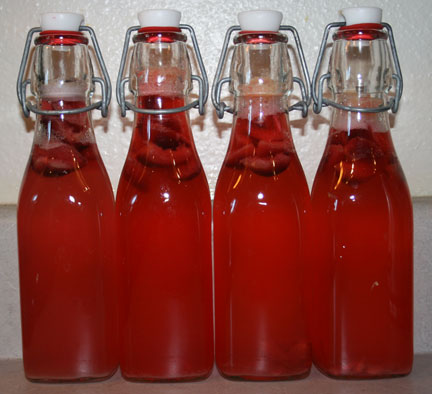FTC Disclosure: Delicious Obsessions may receive comissions from purchases made through links in this article. As an Amazon Associate I earn from qualifying purchases.Read our full terms and conditions here.
I know, I know, another water kefir post?
Didn’t you just post about water kefir recently, Jessica?
Yes, yes I did. I know I just discussed water kefir a few weeks ago, but let me tell you. Fermenting in the anaerobic jars has changed my water kefir life! 🙂 I seriously cannot get enough of the stuff and I am bubbling over (pun intended) with excitement about the subject!
This post has come due to quite a few questions that I have received over the last couple weeks about how to make water kefir at home. A long time ago, I wrote a post about how to make water kefir, but that was before I had learned more about fermenting, so I felt like it was time to write an updated post about the subject.
I was initially taught to brew water kefir in a mason jar with a coffee filter over the top. However, now that I have been exposed to more research on the subject, I have found that kefir (both milk and water) need to be anaerobic ferments. The only ferment that needs to be done aerobically is kombucha. So, since then, I have been using the anaerobic jars for my fermenting and I have never been happier with the switch!
Now, I know many people ferment in the Fido jars, and I did too for a long time. I feel an obligation to insert a couple notes here about the Fidos.
1. I have been told that the Fidos can (and sometimes do) explode. I know of at least one person who had a Fido jar explode in their house, sending shards of glass everywhere. So, proceed with caution if you are using a Fido jar for your water kefir. You can burp your Fido jar once or twice during the fermentation process to let off some of the gas buildup.
2. I have been told that Fido fermenting is not the best option long-term, because of the gas build-up that happens during the fermenting process. Some people say that the Fido will burp itself to let off excess pressure. Others say it won’t “self-burp” and that all the gas is building up in the ferment, can (and will) cause damage to the nutrients we work so hard to cultivate in our ferments. I wanted to share so that you can make the best decision for your family.
OK. On with the fun stuff! 🙂
What The Heck is Water Kefir?
First, I’m sure some people might be wondering what water kefir is? Well, water kefir is a probiotic beverage that is full of all sorts of goodies, like beneficial bacteria, yeasts, enzymes, and vitamins. I always say that true health begins in the gut and water kefir is just one more tool in the arsenal of probiotic foods. It’s safe for everyone in the family to enjoy, even the kiddos. It’s especially good for people who are transitioning away from soda habits because it gives you a fizzy, slightly sweet replacement for those bad-for-you sodas!
Water kefir is also called “Tibicos” and according to Wikipedia, it is a
“Culture of bacteria and yeast held in a polysaccharide matrix created by the bacteria. As with kefir grains, the microbes present in tibicos act in symbiosis to maintain a stable culture. Tibicos can do this in many different sugary liquids, feeding off the sugar to produce lactic acid, alcohol (ethanol), and carbon dioxide gas which carbonates the drink.”
This type of beverage is found all over the world. No two cultures are going to be exactly the same because the bacteria and yeasts can vary depending on the environment that they are in. According to the Cultures for Health, there are over 30 different varieties of bacteria that can be present, along with over 10 varieties of yeasts! This beverage is chock full of all sorts of goodies!
It is important to note that kefir grains (both water and milk) contain no actual grains. They are just clusters of bacteria and yeasts that form little clumps that sometimes look like grains (see the picture at the top of this post).
Of all the ferments, I think that water kefir is one of the simplest and most rewarding to make. If you get a good batch of grains going, you will have water kefir indefinitely! It can be flavored in a wide variety of ways, using fresh fruits, juices, herbs, and even veggies. It is a fast ferment, tastes delicious, and is especially refreshing during the hot summer months!
OK. That’s Nice. How Do I Make Water Kefir?
Like milk kefir, there really isn’t a set recipe per se. It’s more of a set of basic principles and then you can tailor the process to fit your needs and environment. Note, you can use coconut water instead of sugar water. If you use coconut water, you don’t need to add any additional sugar. I recommend adding some additional minerals, like a few drops of liquid minerals or a clean egg shell. To find a brand of coconut water, check out my coconut water comparison post.
A couple of important notes:
1. Water kefir grains LOVE minerals, so I give them a variety of mineral sources (molasses, maple syrup, sea salt, liquid minerals, egg shell, etc.). This is especially important if you use filtered water, or reverse osmosis water (like me). Depending on what type of water you use and how many minerals are in it, you can adjust the additional supplementation to see what works. If you use too much molasses, it will turn the grains brown, and your finished water kefir will be brown. This is not bad, but some people really don’t like the taste of molasses, so this might be too strong for them. I personally prefer to use maple syrup because of the milder flavor.
2. If you have just purchased dehydrated grains, you’ll need to rehydrate them first, before brewing your first batch, Cultures for Health has great information on how to get your grains up and running.
3. If your grains are really happy, they will multiply with each batch. It could be a little, or a lot. It all depends on the water and how the grains are “feeling”. 😉 These extra grains can be given away, used to start additional batches of water kefir, added to smoothies, yogurt, or cereal for a probiotic boost, or, if you’re like me, you can just eat them plain. I love them!
Water Kefir “Recipe”
makes 1 liter (I use a 1L anaerobic fermenting vessel)
I have linked to the products from my affiliate partners that I personally use and recommend.
Ingredients:
- 1/4 cup organic sugar (cane, rapadura, or sucanat work best)
- 1 liter of water (filtered)
- 1/8 tsp. unrefined sea salt
- a few drops of liquid minerals
- 1/2 tsp. molasses or 2 tsp. maple syrup
- 1/2 egg shell (clean)
- 1/4 – 1/2 cup water kefir grains
Instructions:
- Dissolve the sugar, sea salt, and molasses or maple syrup into 1 cup of hot water.
- Let mixture cool to room temp and pour into your fermenting jar.
- Add the egg shell and water kefir grains and fill with the rest of your water to make 1 liter.
- Snap the lid shut, add the airlock, and let sit at room temperature for 12-36 hours. Place the jar in a dark area, like a cupboard. Exposure to UV light can damage all the goodies that you are trying to create (this applies to all ferments). The length of the fermentation will vary, depending on the temp of your house and how active your grains are. You want most of the sugar to be eaten up by the water kefir grains. The final taste should be only slightly sweet and a teeny bit yeasty. My batches brew to the flavor I like in 16-24 hours during the summer since my house gets so hot (no AC or any cooling system). During the winter, however, it takes upwards of 4-6 days for my brew to be done. My house stays around 66 degrees during that time.
- At this point, you can strain off the grains and start a new batch. You can drink the finished kefir as is, or do a second ferment like I do. I honestly don’t recommend drinking the water kefir plain. I think it tastes a little weird and is much more palatable once it’s been flavored. But, taste it and see what you prefer.
- To do the second ferment, just pour up your water kefir in your bottles (I like the Grolsch-style bottles), add whatever flavoring you want – fruit, fruit juice, dried fruit, mild vegetables / vegetable juice / herbs are all nice. Leave the bottles out at room temperature for 24 hours. I usually leave mine in a cupboard or cardboard box (to avoid UV light and keep any potential explosion contained). After the 24 hours is up, move to the fridge and let chill completely before serving.
Check out this Water Kefir Flavor Guide for lots of ideas on how to flavor your water kefir!
Some of my favorite flavors are red cherry lemonade, peach blueberry, cranberry lemonade, and plain lemon or lime juice. Below is the picture of my red cherry lemonade during their second ferment. These are the smallest flip-top bottles I have and they allow the water kefir to get super fizzy! Leave about an inch between the top of the kefir and the lid.

Have you made water kefir before? What is your favorite flavor? Do you have any questions about the subject? Leave me a comment below with your questions and I’ll add them to my water kefir FAQ page! You can also read my recent post “Water Kefir Revisited“.
For more information on water kefir, check out these posts:
- How to Make Water Kefir
- 52 Weeks of Bad A** Bacteria – Week 23 – Water Kefir Revisited
- Water, Water, Everywhere, and Lots of Drops to Drink!
- Water Kefir Flavor Guide – Lots of Delicious Fizzy Flavors!


163 Comments